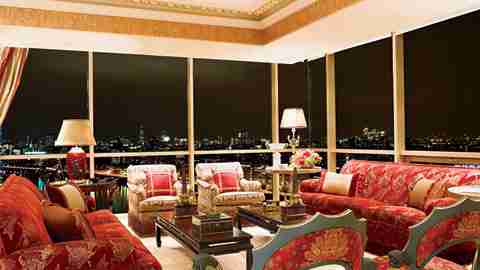The Height of Luxury in London
View Slideshow

A Russian businessman for whom the New York- and Paris-based designer Juan Pablo Molyneux was in the process—the practically unprecedented process—of putting together a 170,000-square-foot house (think three White Houses—that's about the size of it) recently commissioned him to turn his dab hand to a mere 5,000-square-foot space: a London apartment, where the daughter of the family, a lawyer, would live, and where the businessman and his wife would stay when visiting the city from their other homes, in Brussels, Saint-Jean-Cap-Ferrat, Tash-kent and Moscow, not to mention the colossus-in-progress outside Moscow.
The apartment takes up the entire 19th floor of a 20-story glass tower with 360-degree views of what the daughter sums up as "pretty much everything," meaning the whole pageant of London, from its history-steeped streets, bridges, museums and monuments to its river, the Thames of legend, which on a clear day is thrillingly visible from every room. "To come up with interiors that could compete with those vistas—that was my challenge," says Molyneux.
The daughter had told him she wanted the apartment to be contemporary, light and fresh, while her parents had informed him that they expected it to be "extremely Neoclassical," with paneling and gilding, elaborate draperies and scads of French furniture. How was a designer to reconcile these styles? "Rather than stay here in the 21st century and think déjà vu, I dreamed myself back to the 18th and thought ahead to the future, which is to say the present. That's how I was able to dispense so much prescient refreshment—as anybody can see, these rooms breathe a lot more than your normal Neoclassical interior."
To help keep the spirit of the apartment forever light, Molyneux had the living room paneled in straw marquetry, which he insists has a sheen not obtainable from paint or any other surface treatment. "It was used in France and Italy in the 17th and 18th centuries and then revived in the 1920s through the '40s—it's a material you can adapt to whatever trip you're taking in history," he explains, mentioning that Jean-Michel Frank was one of its great champions. Molyneux cast his marquetry in a Neoclassical pattern, repeating it on the room's five double doors; what's more, he intercut the straw panels with pilasters made of scagliola, whose intricate veining resembles ornamental marble. "All the really grand-scale Russian palaces have scagliola," he points out. In other words: The owners should feel right at home here.
The living room's 18th-century Italian carved-white-marble fire surround is Neoclassical; so is the design of the parquetry floor. The palette, with its undercurrent of flame, calls up an incendiary London sunset: Silk-damask draperies, embossed-velvet sofas and Oriental area rugs all radiate red and gold. The distinguished furniture includes a 19th-century French cabinet, from one of the great Rothschild houses, made of 17th-century pietra dura, and some rare early-19th-century Russian painted and gilded armchairs that, from the back, look like the tiaras of a czarina.
The designer opted for screens to separate the living room from the dining room and had them Chinese-lacquered the color of straw. The Karelian-birch chairs are early-19th-century Russian and the chandelier Russian Neoclassical, but the main attraction in this long, narrow, gallery-like room with its straw-colored stucco walls is the table that Molyneux himself created. Ebony-based, it disengages at a touch to make three freestanding square tables that can seat four each. Their tops are scagliola, and they move the designer to rhapsody—"As many interesting things as you can see out the big picture window here," he says, "you can see when you look down at the surface and into the depths of my tabletops."
The library is a pleasing square, its dome ceiling painted with stars and signs of the zodiac in a heavenly blue. Molyneux found the 19th-century Russian desk and armchairs in London. The almost-wall-to-wall blue-brown-gold-and-rust rug is 19th-century French, the mahogany paneling French Neoclassical. "It's a 24-hour room," the designer pronounces. "Nice at night and divine in the day."
The transition to the master bedroom consists of an octagonal vestibule fancifully trompe-l'oeiled as a birdcage complete with parrots, cockatoos, macaws—"whatever flies." To this sensational aviary Molyneux added 19th-century porcelain birds as well as an elegant perch in the form of a marble-topped gueridon.
The master bedroom beyond was dreamed up as a "happy fairy-tale room," with ivory silk walls, a Savonnerie carpet and Russian mahogany-and-gilt chairs. Each of the three circa 1760 watercolors over the bed affords a famous view of St. Petersburg. The mauve-French-damask-upholstered headboard Molyneux describes as "rather Venetian."
The daughter's bedroom, on the other hand, is deliriously Venetian, all silvery and sky blue and embellished with Venetian-glass mirrors—not for nothing is it called the Venetian Suite. "It's very stylish," she says, adding, "like everything here. I must say I love the very contemporary-looking finishes and colors—and the antique pieces around the flat make it a bit more formal and satisfy my parents."
So then, who won? Daughter or father and mother? Contemporary or Neoclassicism? "Me!" Juan Pablo Molyneux laughs. "I gave them contemporary Neoclassicism."